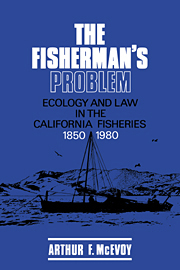Book contents
- Frontmatter
- Contents
- List of figures
- List of tables
- Preface
- Acknowledgments
- List of abbreviations
- Introduction
- I The miner's canary
- II Sun, wind, and sail, 1850–1910
- III The industrial frontier, 1910–1950
- IV Enclosure of the ocean, 1950–1980
- Conclusion
- 11 An ecological community
- Appendixes
- Notes
- Selected bibliography
- Index
11 - An ecological community
Published online by Cambridge University Press: 06 January 2010
- Frontmatter
- Contents
- List of figures
- List of tables
- Preface
- Acknowledgments
- List of abbreviations
- Introduction
- I The miner's canary
- II Sun, wind, and sail, 1850–1910
- III The industrial frontier, 1910–1950
- IV Enclosure of the ocean, 1950–1980
- Conclusion
- 11 An ecological community
- Appendixes
- Notes
- Selected bibliography
- Index
Summary
Highest good is like water. Because water excels in benefiting the myriad creatures without contending with them and settles where none would like to be, it is like the way. … It is because it does not contend that it is never at fault.
– Lao-tzu (551–479 B.C.), Tao Te ChingNearly two centuries elasped between the first commercial slaughter of sea otters in the California Current and the development of plans for managing the system's resources under the Fishery Conservation and Management Act of 1976 (see Fig. 11.1). Over those two centuries, the commercial harvest left in its wake a trail of devastation: By their end, both the quantity and the diversity of life in the current had fallen to unprecedentedly low levels. The destruction was both cyclical and cumulative, the different sectors of the industry depleting their resources, colonizing new ones, and depleting them in turn without altering significantly their essential characteristics or patterns of behavior. Only during the 1970s, by which time California's domestic fisheries had nearly destroyed themselves, was there any indication that the cycle of depletion and colonization might at last be broken.
Despite changes in the style of government efforts to conserve the fisheries, the century of such efforts that preceded FCMA was continuous in character as well. Ideally, the function of government was to account the social costs of resource use and then to compel harvesters to behave in ecologically conservative ways so as to save them from the self-destruction to which a more narrowly construed market rationality might lead them.
- Type
- Chapter
- Information
- The Fisherman's ProblemEcology and Law in the California Fisheries, 1850–1980, pp. 251 - 258Publisher: Cambridge University PressPrint publication year: 1986

